For the past 35 years, artist and YJ’sSnackbar owner David Ford has been traveling to Guatemala.
His interests in the area have ranged from local foods and recipes to indigenous festivals and politics. But recently, his focus has narrowed — he’s become totally obsessed with broken doll heads, called muñecas, used in bustling marketplaces to advertise hair-braiding and hair-wrapping services to white tourists.
“It’s an advertising thing,” Ford explains.
According to Ford, the doll speaks to the tourist who does not know the indigenous languages spoken in any given village. The message of the advertisement is, "I will braid your hair, tourist."
The first time Ford bought a muñeca from a vendor it cost him $3. The vendor laughed at him, confounded by this crazy white man in a bandana, speaking rusty Spanish and buying a broken doll, which wasn’t created for consumption.
Nonetheless, about a week later, he returned to the same spot and the same vendor eagerly approached him to show off her new muñeca. The hair on this one was more expertly braided. And this one cost $5.
The monetary value of a muñeca had gone up almost 100 percent in a week.

Six years and many trips later, the starting price for muñecas is about $45, and the number of shops that have them has gone up dramatically to satisfy what is most likely a market of one — Ford himself.
For his current exhibit at the UMKC Gallery of Art, Ford enlisted an economist (who prefers to remain nameless) to help him create a formula quantifying the effect he’s had on the market for munecas in the towns he visits. That economic problem is at the heart of his artistic project.
“I’m trying to figure out value,” he says. “I’m doing an interpretive value to see whether attention can make something more valuable or not.”
In part, Ford’s line of questioning is a metaphor for the high end art market. Where there isn’t a practical need being met by an object, and where prices are not based on objective aesthetic values, but on a complex and highly manipulated marketof relationships and reputations.
As for direct statements on what he’s trying to say, those are hard to come by.
Ford hints at a conclusion, but stops short of articulating it, joking that “you don't want to poke the stick at the economic bear or poke the stick at the art world bear.”
He does allow that he prefers the art that comes from culture to the culture that comes from art. But he isn’t just exploring the art world through this lens. He’s also questioning himself.

“I think it’s an important thing, to have questions and be an artist with a passport,” he says. “I began to look at myself and ask, ‘Why am I interested in this doll? And why is the market responding?’”
He realized that most of the time when he approaches vendors in foreign countries about their wares it’s not the objects he’s most interested in. What he wants it an excuse to have a conversation.
“The basis of a lot of economics is that social dynamic,” he says.
In the meantime, he is hoping to inspire conversations about tourism, post-colonialism and economics, and to get people scratching their heads at the complex economic equations hand painted in dripping cursive lettering on the gallery walls behind row after row of increasingly expensive muñeca dolls.
The Muñeca Project, March 5 - April 3, UMKC Gallery of Art, Department of Art and Art History, 204 Fine Arts Building, University of Missouri-Kansas City, 5015 Holmes Street, Kansas City, Mo.





